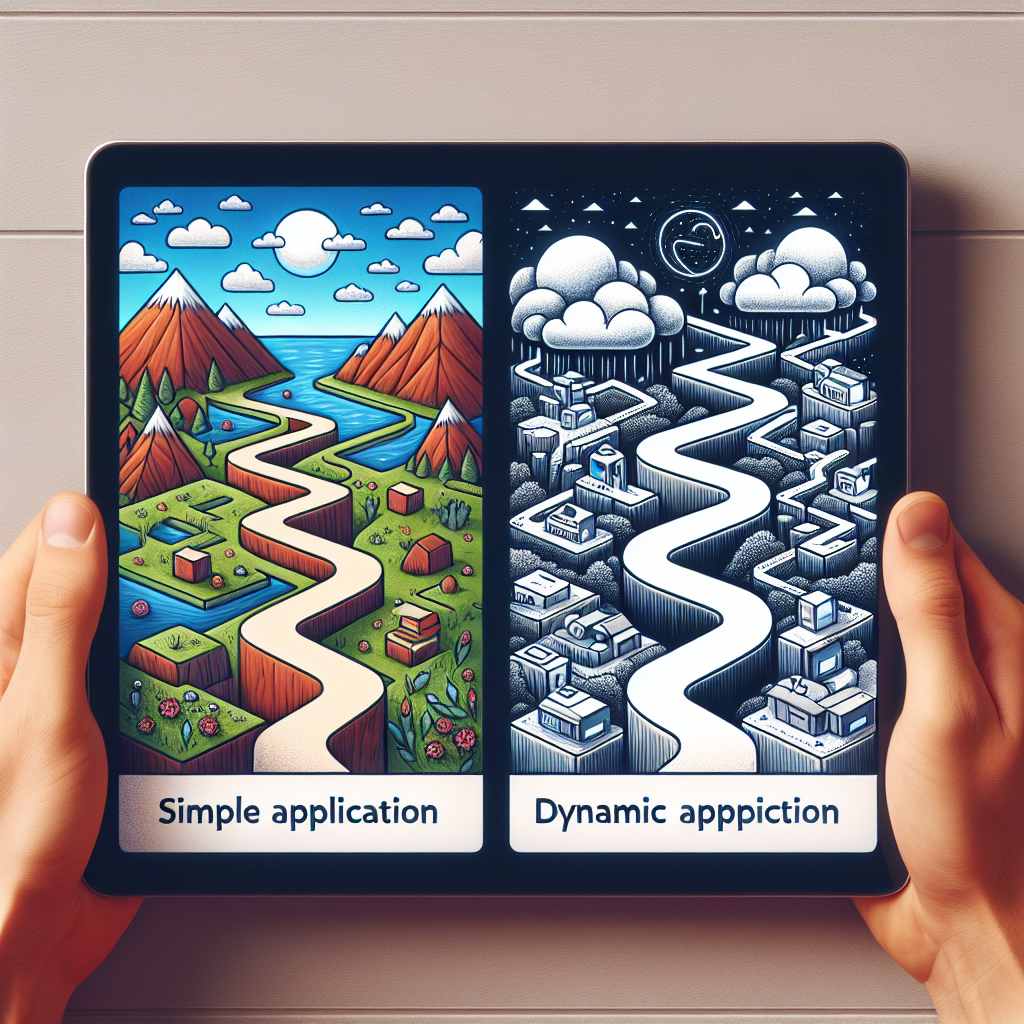What is the Backend of an Application? Understanding Its Essential Role
Have you ever wondered what makes your favorite apps run smoothly behind the scenes? Thats where the backend of an application comes into play! The backend is like the engine of a car: it’s not always visible, but it powers everything, ensuring your experience is seamless and enjoyable. ⭐
Defining the Backend
So, what exactly is considered backend? Simply put, it encompasses all the components that process and manage data. This includes servers, database management, application logic, and API integrations. All these elements work together to provide a coherent experience for users while they interact with the front end of the application.
Examples You Can Relate To
- Imagine using an online store. ⭐ When you add items to your cart, the backend securely updates the database to reflect your choices.
- Think about your favorite social media platform. ⭐ When you like or share a post, the backend is responsible for processing that action and ensuring it appears instantly.
- Consider a food delivery app. ⭐ The backend retrieves restaurant menus, calculates delivery times, and manages your order – all without you seeing a line of code!
The purpose of the backend is crucial—it’s designed to deliver data quickly and efficiently. Did you know that a 1-second delay in page response can lead to a 7% reduction in conversions? Thats huge! When the backend is optimized, users enjoy a smoother interaction, leading to better retention rates and increased sales. ⭐
What is included in backend development? It consists of:
- Database Management: Storing and organizing data.
- Server-Side Scripting: Writing code that runs on the server to respond to client requests.
- API Frameworks: Helping different applications communicate with each other.
- Security Measures: Protecting data and ensuring user privacy.
| Component | Description |
|---|
| Database | Stores application data securely. |
| Server | Processes requests and responses. |
| Application Logic | Handles the business rules of the app. |
| API | Connects the frontend and backend. |
| Security | Protects data privacy and integrity. |
| Hosting | Where the application lives on the internet. |
| Monitoring | Ensures the system is up and running. |
| Backup | Data recovery plans and strategies. |
| Integration | Working with other services and platforms. |
| Scaling | Adapting the system as user demand grows. |
Do All Applications Have a Backend?
Many might wonder, do all applications have a backend? The answer is generally yes! However, some simple mobile apps (like a calculator) may not have a traditional backend. But for complex applications, having a backend holds paramount importance. It allows for dynamic content management and complex functionalities, enhancing user interaction and satisfaction.
Want to create the backend of an application that meets and exceeds todays expectations? Our team at webmaster.md has over 20 years of experience crafting tailored solutions just for you! A single point of contact for all your IT needs, we promise hassle-free integration and professional support. ⭐ Call us today at +373 601 066 66 or sign up on our website to get started!
Ready to Take the Next Step?
Don’t wait! Your apps performance is crucial for success. Let’s build a robust backend that keeps your users satisfied and engaged. We’re here to help you every step of the way. Reach out now and transform your digital presence!
Frequently Asked Questions
- What is the backend of an application? It is the part of the application that handles the business logic and data management without direct user interaction.
- What is considered backend? Backend includes server-side processing, database management, and APIs that support the apps functionality.
- What is the purpose of the backend? Its main purpose is to ensure the application works properly, manages data, and responds to user requests swiftly.
- What is included in backend development? Backend development includes database management, server-side scripting, API integration, and security measures.
- Do all applications have a backend? Most applications do, especially those that require data management or user interaction beyond simple tasks.
- How can I create the backend of an application? You can work with IT specialists to define your needs and implement an architecture that suits your application.
- How important is backend optimization? Extremely important! Proper backend optimization improves app performance and user experience significantly.
- What technologies are used in backend development? Common technologies include Node.js, Ruby on Rails, Python, and various database systems.
- How do you ensure backend security? By implementing strong encryption, regular updates, and security protocols.
- Why choose webmaster.md for backend services? We provide a comprehensive range of IT services with expert support tailored to your needs, all in one place.
What is Considered Backend? Keys to Effective Application Functionality
Have you ever clicked "send" on an email or "confirm" on an online order and wondered what happens next? The magic that ensures everything works seamlessly lies in the backend of an application. So, what is considered backend? Let’s explore its key components and how they contribute to effective application functionality! ⭐
The Backbone of Technology
The backend is the powerhouse of any application. It consists of multiple elements working together to manage data, process requests, and maintain functionality. Here’s what’s included:
- Server: The server is where all the application’s processes take place. Think of it as your computers brain, handling requests from users—like fetching data or storing information.
- Database: This is where all necessary data is stored. Whether its user profiles, transaction records, or content, databases are crucial for every applications performance.
- Application Logic: This is the layer where the “thinking” happens. It processes user requests, enforces business rules, and dictates how data flows from one component to another.
- API (Application Programming Interface): APIs allow different parts of an application or different applications to communicate. They act as the messenger delivering requests and responses smoothly.
- Security Measures: Data security is non-negotiable. The backend must have protocols to protect user data and maintain privacy, ensuring trust and compliance.
Why Backend Matters for Your Application
Understanding what is the purpose of the backend shines light on its importance. Without an effective backend, your application can become slow, unresponsive, or even prone to security breaches! Here are some reasons why backend is essential:
- Performance: A well-structured backend enables fast data retrieval and processing, enhancing user experience. ⭐
- Scalability: As user demand grows, your backend needs to scale efficiently. A robust design ensures your app can handle increased loads without compromising performance.
- Maintenance: An organized backend allows for easier updates and debugging, which keeps your application running smoothly over time.
- Integration: Backend APIs facilitate integration with third-party services like payment gateways, social media platforms, or analytics tools, expanding your applications capabilities.
Backend Development Technologies
So, what technologies are typically involved in backend development? Here are some key players:
Creating an Effective Backend
How can you ensure that your applications backend is effective? Here are some actionable tips:
- Prioritize Optimization: Regularly optimize your database for faster queries and improved data retrieval. ⚙️
- Implement Security Best Practices: Always use encryption for sensitive data and keep your software up to date to minimize vulnerabilities.
- Monitor Performance: Use tools to monitor application performance and identify bottlenecks, allowing for timely interventions.
- Plan for Scalability: Design your backend architecture with scalability in mind, ensuring that it can grow with your user base.
- Documentation: Maintain clear documentation for developers to easily understand the codebase and streamline future updates.
If you are looking to supercharge your applications backend, webmaster.md is here for you! With 20 years of industry experience, our professional specialists can help you build a backend that meets your unique requirements. ⭐ Call us today at +373 601 066 66 or visit our website to start your journey toward enhanced app functionality!
Ready to Enhance Your Applications Backend?
Don’t miss the opportunity to ensure your application performs at its best. By investing in an effective backend, you lay down a solid foundation for your application. Let’s build something great together!
Frequently Asked Questions
- What is considered backend? The backend encompasses servers, databases, application logic, APIs, and security measures that facilitate application functionality.
- Why is backend important? It ensures efficient data management, application performance, and allows for secure user interaction.
- What is included in backend development? It includes designing the architecture, database management, server configurations, API development, and implementing security protocols.
- What technologies are used for backend development? Common technologies include Node.js, Ruby on Rails, Python, PHP, Java, MySQL, MongoDB, and AWS.
- How does backend impact user experience? A well-structured backend ensures that users experience speed, reliability, and accurate results.
- Can I scale my app with a solid backend? Yes! A well-designed backend supports scalability to accommodate growing user demands.
- How often should I optimize my backend? Regular optimization is recommended based on the changing traffic and usage patterns of your application.
- What security measures should I consider? Implement encryption, regular updates, and strong access controls to protect user data.
- Can I integrate third-party services through the backend? Absolutely! Using APIs allows you to integrate various external services into your application.
- Why choose webmaster.md for backend development? We offer a complete range of IT services, ensuring that you receive tailored solutions and effective support all in one place.
What is the Purpose of the Backend? Uncovering Its Critical Impact on User Experience
Have you ever stopped to think about what keeps your favorite apps running smoothly? That behind-the-scenes magic is driven by the backend of an application. In this chapter, we’ll explore the core purpose of the backend and how it significantly influences user experience. ⭐
The Array of Functions Served by the Backend
At its heart, the purpose of the backend is to manage data and facilitate communication between the server, database, and user interface. Here’s how it works:
- Data Management: The backend stores, retrieves, and manipulates data efficiently, ensuring that users get the information they need quickly and accurately.
- Server Processing: Servers handle requests from the frontend (what users see) and send back the necessary information. For example, when you search for a product, the server retrieves relevant data from the database.
- Business Logic: This is where the "rules" of your application reside. The backend processes data according to these rules, such as applying discounts during a sale or determining user permissions.
- Authentication: The backend verifies user identities and manages access permissions, ensuring that personal data is kept secure. ⭐
- Integration with Third-Party Services: Many applications rely on integrations (like payment processors or external databases) to enhance functionality, all managed through the backend.
Why is understanding the backends purpose so crucial? Because it directly affects user interaction with your application. Here are some of the ways the backend impacts user experience:
- Speed: A well-optimized backend can drastically reduce load times. Research shows that a mere 1-second delay in response can lead to a 7% decrease in conversions. ⭐
- Reliability: Users expect applications to perform consistently. A stable backend ensures that even during peak usage times, the application remains responsive.
- Security: Users share sensitive information daily. A strong backend protects this data through encryption and secure authentication, creating a trust relationship. ⭐️
- Dynamic Content Delivery: The backend enables applications to present real-time updates and personalized content, making the user experience more engaging and relevant.
- Error Handling: Robust backends can identify and respond to errors effectively, providing users with clear feedback rather than causing frustration. For example, if a product is out of stock, a well-designed backend can notify users and suggest alternatives.
Real-World Impacts of a Poor Backend
To illustrate the backends critical role, lets look at a scenario. Imagine a popular e-commerce site that suddenly experiences a surge of traffic during a holiday sale. If their backend isn’t equipped to handle the high volume of requests, users may face long loading times, broken links, or data loss. This could lead to not just lost sales, but also significant damage to their reputation. ⭐
The architecture of your backend significantly influences both performance and user satisfaction. The backend can be designed thoughtfully with the following considerations:
- Microservices: Using a microservices architecture allows different parts of your application to scale independently, improving performance during high traffic times.
- Cloud Deployment: Hosting your backend in the cloud can enhance reliability and accessibility, allowing resources to be dynamically allocated based on current demand.
- Load Balancing: Distributing incoming requests among multiple servers ensures that no single server is overwhelmed, maintaining speed and reliability.
Improving backend performance can lead to a notable uptick in user satisfaction. Here are some actionable recommendations:
- Conduct Regular Performance Testing: Identify bottlenecks in your backend system and resolve them proactively to maintain smooth operations.
- Implement Caching Mechanisms: Store frequently accessed data closer to the user to reduce load times, minimizing server requests.
- Optimize Database Queries: Reduce the complexity of queries and structure your database properly to enhance retrieval speed.
- Utilize API Gateways: Manage and consolidate API calls through an API gateway, improving security and performance.
At webmaster.md, we specialize in developing backends that not only support functionality but also elevate the user experience. With our rich expertise and comprehensive service scope, we’re here to help you build a robust backend that meets your needs. ⭐ Call us at +373 601 066 66 or visit our website to learn more about how we can empower your business!
Final Thoughts
In conclusion, understanding the purpose of the backend is essential for anyone involved in application development. With an efficient backend, you create a solid foundation for a superior user experience. Ready to dive deeper?
Frequently Asked Questions
- What is the purpose of the backend? The backend manages data, processes user requests, and ensures application functionality behind the scenes.
- How does the backend impact user experience? A well-structured backend provides speed, reliability, and security, enhancing overall user satisfaction.
- What key features should a backend have? It should offer data management, security protocols, server processing, and dynamic content delivery.
- What happens if the backend fails? Users may face errors, slow responses, and data loss, all of which can lead to a poor experience and loss of trust.
- How can I improve my applications backend? Regular performance testing, caching mechanisms, and optimizing database queries can enhance backend functionality.
- Is backend development important for all applications? Yes, virtually all applications can benefit from backend development for effective data handling and management.
- What are microservices? Microservices are an architectural approach that structures an application as a collection of loosely coupled services, improving flexibility and scalability.
- Can a poor backend affect sales? Absolutely! If an application is slow or unreliable, it can deter users from completing transactions, impacting revenue.
- How often should I update my backend systems? Regular updates and maintenance should be planned as part of your IT strategy to ensure optimal performance.
- Why choose webmaster.md for backend services? With 20 years of experience, we offer comprehensive services tailored to your unique needs, ensuring effective and efficient backend solutions.
Do All Applications Have a Backend? Debunking Myths and Exploring Modern Trends
If you’ve ever wondered whether every application needs a robust backend, you’re not alone! Many people are curious about the critical role of the backend of an application and the emerging trends in technology. Let’s debunk some myths and explore whether all applications have a backend. ⭐
Myth or Fact: Do All Applications Have a Backend?
First, lets clarify: the straightforward answer is that not all applications have a traditional backend. Many simple applications—especially mobile apps designed for straightforward functions—can operate with limited or no backend support. But what does that mean for more complex applications? Here’s how it breaks down:
- Frontend-Only Applications: These apps can function primarily on the client side, meaning all the data processing happens on the device itself. A good example is a simple calculator app; it doesn’t require a backend server to function.
- Server-Less Applications: With cloud services, some apps use APIs to interact directly with multiple third-party services instead of a dedicated backend server. These are often called server-less applications, and they can still offer robust capabilities while offloading heavy lifting to external services.
- Static Websites: Think of blogs or informational sites that primarily deliver content without dynamic interaction. These can be hosted without a traditional backend, serving static HTML pages directly to users.
When Do You Need a Backend?
The need for a backend often arises from specific requirements. Here are scenarios where a backend is essential:
- Data Management: If your application requires storing and retrieving user data—like user accounts or custom preferences—a backend is vital.
- User Authentication: Apps that require user login systems need a backend to manage sessions securely and verify identities.
- Dynamic Content: Applications that deliver personalized content or updates in real time, such as news apps or social platforms, heavily rely on a well-structured backend. ⭐
- Scalability Requirements: For businesses expecting high traffic or growth, a robust backend ensures the application can handle more data and users without slumping performance.
Modern Trends Shaping Backend Development
In the evolving landscape of technology, several trends are significantly impacting the need for backends:
- Microservices Architecture: This allows applications to be built using loosely coupled services that can scale independently, improving flexibility and maintenance. ⭐
- Cloud Computing: Cloud services enable applications to store data and run processes without the need for a physical backend server, allowing for easier integration and cost savings.
- API-Driven Development: Many modern applications leverage APIs to communicate with third-party services, reducing the need for an extensive backend while maintaining functionality.
- Serverless Computing: This approach allows you to run applications without managing infrastructure. Companies pay only for what they use, making it cost-efficient while ensuring performance. ☁️
When to Opt for a Backend Solution
Ultimately, the decision to implement a backend service depends on your applications goals and functionalities. If you plan to manage user data, support complex interactions, or need robust security, investing in a backend is a wise choice. ⭐
Real-Life Scenarios
Let’s explore a few real-life scenarios to illustrate when a backend is crucial:
- E-commerce Platforms: A customer browses a clothing store. As they add items to their cart, the backend manages inventory, processes orders, and ensures secure payment transactions.
- Social Media Apps: A user posts a new photo. The backend processes that request, updating the feed for all friends, managing likes, comments, and notifications in real time.
- Gaming Applications: An online multiplayer game relies on the backend to synchronize player actions and maintain state across hundreds of players simultaneously. ⭐
If you’re curious about developing an application with a powerful backend, webmaster.md is here to guide you through every step. With 20 years of experience and a full spectrum of services, we can help sculpt the ideal infrastructure for your project. Don’t hesitate to reach out at +373 601 066 66 or visit our website!
Final Thoughts
As we’ve explored, not all applications necessarily require a traditional backend, but understanding when and why you might need one is essential for effective application development. With modern trends influencing backend functionality, there are numerous avenues available to explore. Are you ready to innovate?
Frequently Asked Questions
- Do all applications have a backend? Not all do—simple or static applications can function without a traditional backend.
- What applications require a backend? Applications requiring data management, user authentication, or dynamic content typically need a backend.
- What is a serverless application? These apps utilize third-party services through APIs without a dedicated backend server.
- How do APIs affect backend development? APIs allow flexible communication with external services, sometimes reducing the need for complex backends.
- What are microservices? A design approach where applications are built as independent frameworks to improve scalability and management.
- How does cloud computing impact backend solutions? It provides cost-effective storage and processing capabilities without requiring physical infrastructure.
- When should I invest in a backend solution? When your application requires data handling, security, or is expected to grow significantly.
- What are the benefits of serverless computing? Lower operational costs and scalability, as you only pay for the resources you use.
- Can I develop applications solely using frontend technologies? Yes, but your applications will be limited to simple functions and offline capabilities.
- Why choose webmaster.md for backend services? We offer tailored backend solutions ensuring your application meets all necessary functionalities with expert support.






